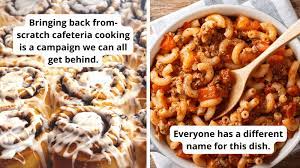Introduction
Cafeteria food often has a reputation for not being the most nutritious or delicious option for students. Teachers, as regular visitors to their school’s cafeteria, have a unique perspective on the quality of the food that is served to children every day. In order to better understand this perspective, I asked multiple teachers about their experiences with school cafeteria food and compiled a list of 11 key takeaways.
1. Cafeteria food varies greatly between schools and districts
Some teachers reported that their school offers diverse and nutritious options for students, while others noted sub-par food quality. This inconsistency is often linked to differing budgets, resources, and food policies in place across various school districts.
2. Nutrition is a concern
Many teachers expressed concern about the nutritional content of cafeteria food, pointing out high salt, sugar, and fat levels in certain dishes. They believe healthier options should be offered alongside kid-friendly favorites.
3. Budget constraints impact meal quality
Teachers acknowledged that one major factor affecting cafeteria food quality is budget constraints in their schools. Limited funding forces schools to make tough decisions regarding ingredients and food variety.
4. Cafeterias often prioritize convenience over taste
Pre-packaged meals or simple-to-prepare dishes are common in school cafeterias, as they save time and money. However, these options may compromise taste—many teachers said that this trade-off results in less-than-delicious choices for students.
5. Allergies and dietary restrictions pose challenges
Providing food that caters to students with various allergies or dietary restrictions while adhering to budget constraints can be difficult for some schools.
6. The importance of fresh produce
Many teachers wished their school’s cafeteria provided more fresh fruits and vegetables for the students but noted that cost can be a barrier to doing so regularly.
7. Cultural preferences impact menu selection
Diverse student populations may prefer dishes reflective of their cultural backgrounds, but teachers acknowledged that tight budgets often mean limited cultural offerings on the menu.
8. Food waste is a concern
An issue many teachers noticed in the cafeteria was food waste. They suggested that creative solutions should be used to repurpose leftovers and minimize waste.
9. The quality of the food may impact student behavior
Some teachers noted that when students consume unhealthy or unsatisfying food, it may affect their mood, energy levels, and overall behavior during the school day.
10. School staff play a vital role
From cafeteria workers to custodial staff, they are responsible for preparing and serving meals and maintaining a clean environment. Teachers emphasized their importance in the overall cafeteria experience for students.
11. Improving cafeteria food is an ongoing process
Most teachers expressed a desire for continual improvement in school cafeterias—whether through greater variety, improving nutrition, or simply offering better-tasting options for students.
Conclusion
It’s clear that the quality of school cafeteria food varies greatly and is impacted by various factors, from budgets to cultural considerations. However, teachers provide valuable insight into these issues and can advocate for improvements in their schools’ cafeterias to benefit the well-being of their students.





